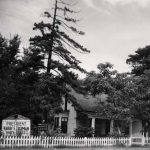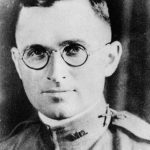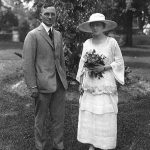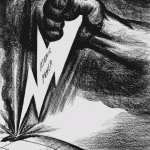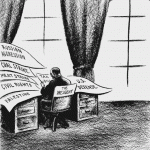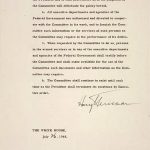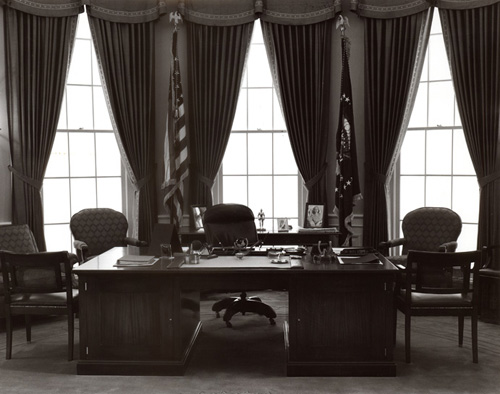
Harry S. Truman

Introduction
Harry S. Truman was the thirty-third president of the United States of America. Truman took over the presidency after serving only a short time as vice president under President Franklin Delano Roosevelt. Known as the plain-speaking man from Missouri, Truman led the United States through the end of World War II and the Korean War, and helped transform the nation into a world superpower.
Early Years and Education
Harry S. Truman was born in Lamar, Missouri, on May 8, 1884. He was the oldest child of John Anderson Truman, a farmer and livestock dealer, and Martha Ellen Young Truman. His siblings were John Vivian and Mary Jane. The family lived in Harrisonville, Grandview, and then moved in 1890 to Independence, Missouri, where Harry attended school.
Harry did well at school and also studied the piano. His poor vision—corrected by thick eyeglasses— prevented him from playing sports. When Harry was ten, his mother gave him Great Men and Famous Women, a book that influenced his life. Harry read about great generals, political leaders, and philosophers. He also read the Bible, Shakespeare, and as much history as he could.
Harry graduated from high school in 1901. He did not go on to college, however, because his family could not afford to send him. He wanted to attend West Point because it provided a free education, but he did not qualify due to his poor eyesight. Though he studied briefly at a business college in Kansas City and later took night classes at the Kansas City Law School, Harry never completed a college degree.
Farm Work and Responsibilities
For the next five years, Harry Truman worked various jobs to help support his family. He was a timekeeper for a railroad construction firm and clerked for a bank in Kansas City. In 1906 he returned to Grandview to help run the six-hundred-acre family farm. Although he had little farming experience, Truman worked hard to learn the best and most efficient ways to farm. He was left to care for his family and the farm when his father died in 1914.
During this period, Truman began writing letters to Bess Wallace, a girl he’d known since early childhood. Truman said later that Bess had been the love of his life since he was six years old. The two wrote to each other often during their long courtship, and his letters were filled with dreams for his future.
Military Service and Politics
Truman served in the Kansas City National Guard unit from 1905 to 1911. When the United States entered World War I in 1917, he rejoined the Missouri National Guard. He recruited for the guard and created a new artillery battery, Battery F. He was elected first lieutenant of that battery. In France, Truman was made a captain and proved a capable and well-liked officer in his new unit, Battery D. Truman was a successful and dependable leader, especially when ordered to carry out dangerous assignments.
After the war ended in 1918, Truman returned to Independence. He and Bess married the following year. Together they had one child, Mary Margaret. Truman then tried his hand at several business ventures. He opened a haberdashery, or men’s clothing store, in Kansas City with one of his army buddies. That business failed, as did investments in real estate and mines.
In 1922, Truman revealed his interest in politics. He ran for office at the urging of Tom Pendergast, a powerful Kansas City politician. Truman, who ran as a Democrat, was elected to the post of Eastern District Judge for Jackson County. He was responsible for overseeing the county budget, hiring and firing county clerks, road crews, and other county employees. Although he didn’t win his bid for reelection, in 1926 Truman won the presiding judge race for Jackson County. He was reelected to that position in 1930.
In 1934 Truman ran as a Democrat for United States Senate and won easily. Once in office, Truman gained a reputation for honesty and hard work. Truman’s work with the Senate Special Committee to Investigate the National Defense Program earned him a national reputation. This committee—known as the Truman Committee—investigated fraud and overspending by the defense industry. It also revealed military incompetence. Truman served as senator from 1935 until 1945.
Suddenly President
Truman was a strong supporter of President Roosevelt and his New Deal. With his reputation for honesty and diligence and his ability to work with a variety of politicians, Truman was Roosevelt’s pick for vice president in 1944. Roosevelt was reelected, and Truman became vice president. He had been on the job only eighty-two days when Roosevelt died unexpectedly. On April 12, 1945, Truman became the thirty-third president of the United States. “I felt like the moon, the stars, and all the planets had fallen on me,” Truman told reporters at the time.
The country was in shock at the loss of Roosevelt. There was concern that the untested Truman was at the helm in a time of crisis—the United States was at war with both Germany and Japan. As usual, Truman jumped in, studied hard, and was a fast learner. On May 7, 1945, the Germans unconditionally surrendered. In July, Truman headed to Germany to meet with Soviet leader Joseph Stalin and British Prime Minister Winston Churchill at Potsdam. Here the three leaders of the Allied powers decided the fate of postwar Europe.
On the Japanese front, the war still raged. It was a costly battle in both American and Japanese lives. Truman made the controversial decision to drop atomic bombs on the cities of Hiroshima and Nagasaki on August 6 and 9, 1945. The Japanese surrendered six days later on August 14, 1945.
A New Era
The international situation remained grim, however. A “Cold War” was developing between the Soviet Union and countries in Europe and the United States. At the end of the war, the United States, France, Great Britain, and the Soviet Union agreed to divide Germany and its capital city, Berlin, into four sectors. Allied forces joined their sectors to form a democratic West Germany and a free Berlin. Berlin, however, was surrounded by Soviet-controlled East Germany. In an effort to stop the formation of a unified and democratic Germany, the Soviet Union attempted a blockade of West Berlin to keep goods, including food, from entering the city. Great Britain and the United States countered with an enormous airlift of supplies. The Soviets backed down. However, Berlin and Germany remained divided into East and West until 1990.
A World Leader
The United States had become the predominant world power. It could no longer distance itself from the problems occurring in other countries as it had prior to the war. Truman knew that the United States and Europe would have to cooperate both militarily and economically if they were to keep the Soviet Union and its communist form of government in check. Truman created the Marshall Plan to help rebuild the devastated economies of Western Europe and support the democratic governments. West Germany became a democratic ally of the United States. Truman established the first peacetime military alliance, known as the North Atlantic Treaty Organization, or NATO, to ensure European and American military and political cooperation. The Truman Doctrine attempted to contain the spread of communism by supporting fledgling democracies. Truman’s administration also oversaw the first meeting of the United Nations.
Tough Times in America
Truman faced many domestic problems as well. Hundreds of thousands of soldiers came home from Europe and the Pacific and could not find work. Factories closed as orders for military goods dried up. Union workers went on strike for better pay and working conditions. The strikers refused to allow nonunion workers to fill their jobs. A railway strike paralyzed the country. Truman seized the railroads and threatened to draft striking railway workers into the armed forces. The railroad workers went back to their jobs.
In an unpopular move, Truman desegregated the United States armed forces by Executive Order on July 26, 1948. Critics thought this would cause the president to lose the upcoming election against New York Governor Thomas Dewey. The race was so close one newspaper prematurely declared Dewey the winner. In the final count Truman won the 1948 election.
Back to Missouri
International events overshadowed Truman’s domestic agenda. He tried to push through his own version of Roosevelt’s New Deal. He called it the “Fair Deal,” stating that every citizen had a right to expect a fair deal from the government. Many of his initiatives were never passed, however. In 1949, the communists took over China. In 1950, communist North Korea invaded South Korea, and the United States was once again at war, siding with South Korea. Truman did not run for a second term as president.
In 1953, Dwight D. Eisenhower became president of the United States. The Trumans left the White House and returned to Independence, Missouri. Truman remained active in politics and worked on establishing the Truman Library and writing his memoirs. He died on December 26, 1972. He was eighty-eight years old.
Truman's Legacy
When Truman left the presidency, the world was far different from when the senator from Missouri was asked to run as Roosevelt’s vice president. Harry S. Truman helped usher in a new world order and set in place policies like the Marshall Plan, the Truman Doctrine, and institutions like the United Nations to try to prevent another world war. Under his leadership, the country embraced its new status as a superpower.
Text and research by Ellen Hosmer, Christine Montgomery, and Carlynn Trout With assistance from Valerie Kemp
References and Resources
For more information about Harry S. Truman’s life and career, see the following resources:
Society Resources
The following is a selected list of books, articles, and manuscripts about Harry S. Truman in the research centers of The State Historical Society of Missouri. The Society’s call numbers follow the citations in brackets.
Articles from the Missouri Historical Review
- Bolt, Robert S. “President Harry S. Truman: Independent Baptist from Independence.” v. 87, no. 1 (October 1992), pp. 36-47.
- Dains, Mary K. “Fulton’s Distinguished Visitors: Truman and Churchill, 1946.” v. 78, no. 3 (April 1984), pp. 277-292.
- Ferrell, Robert H. “A Visitor to the White House, 1947: The Diary of Vic H. Housholder.” v. 78, no. 3 (April 1984), pp. 311-336.
- Garson, Robert A. “The Alienation of the South: A Crisis for Harry S. Truman and the Democratic Party, 1945-1948.” v. 64, no. 4 (July 1970), pp. 448-471.
- Heaster, Brenda L. “Who’s on Second: The 1944 Democratic Vice Presidential Nomination.” v. 80, no. 2 (January 1986), pp. 156-175.
- Kirkendall, Richard S. “Truman and Missouri.” v. 81, no. 2 (January 1987), pp. 127-140.
- Kirkendall, Richard S. “Faith and Foreign Policy: An Exploration into the Mind of Harry Truman.” v. 102, no. 4 (July 2008), pp. 214-224.
- McClure, Arthur F., and Donna Costigan. “The Truman Vice Presidency: Constructive Apprenticeship or Brief Interlude?” v. 65, no. 3 (April 1971), pp. 318-341.
- Misse, Fred B. “Truman, Berlin and the 1948 Election.” v. 76, no. 2 (January 1982), pp. 164-173.
- “Modern Missouri.” v. 70, no. 4 (July 1976), pp. 499-503.
- Morgan, Georgia Cook. “India Edwards: Distaff Politician of the Truman Era.” v. 78, no. 3 (April 1984), pp. 293-310.
- Pitts, Debra K. “Stuart Symington and Harry S. Truman: A Mutual Friendship.” v. 90, no. 4 (July 1996), pp. 453-479.
- Riley, Glenda. “‘Dear Mamma’: The Family Letters of Harry S. Truman.” v. 83, no. 3 (April 1989), pp. 249-270.
- Sale, Sara L. “Admiral Sidney W. Souers and President Truman.” v. 86, no. 1 (October 1991), pp. 55-71.
- Schmidtlein, Gene. “Truman’s First Senatorial Election.” v. 57, no. 2 (January 1963), pp. 128-155.
- Vaughan, Philip V. “President Truman’s Committee on Civil Rights: The Urban Implications.” v. 66, no. 3 (April 1972), pp. 413-430.
- Vaughan, Philip V. “The Truman Administration’s Fair Deal for Black America.” v. 70, no. 3 (April 1976), pp. 291-305.
- Wilson, Thomas D. “Chester A. Franklin and Harry S. Truman: An African-American Conservative and the ‘Conversion’ of the Future President.” v. 88, no. 1 (October 1993), pp. 48-77.
Articles from the Newspaper Collection
- “Truman Dies at 88.” Kansas City Star. December 26, 1972. p. 1. [Reel # 21796]
- “Ex-President Truman is dead at 88.” St. Louis Post-Dispatch. December 26, 1972. p. 1. [Reel # 43398]
- “The People Did It.” Liberty Advance. November 8, 1948. p. 2. [Reel # 26635]
- “President Truman’s Inaugural Address.” Kansas City Star. January 20, 1949. p. 8. [Reel # 20735]
- “Through the Years with Harry Truman, President.” Kansas City Times. April 13, 1945. p. 7. [Reel # 24093]
- “Truman Enters Office With Firm Hand.” Independence Examiner. April 13, 1945. p. 1. [Reel # 14855]
- “Wallace-Truman.” Independence Examiner. June 28, 1919. p 1. [Reel # 14780]
Books and Articles
- Christensen, Lawrence O., William E. Foley, Gary R. Kremer, and Kenneth H. Winn, eds. Dictionary of Missouri Biography. Columbia: University of Missouri Press, 1999. pp. 752-756. [REF F508 D561]
- Ferrell, Robert H., ed. The Autobiography of Harry S. Truman. Columbia: University of Missouri Press, 2002. [REF F508.1 T771tra 2002]
- Ferrell, Robert H. Dear Bess: The Letters from Harry to Bess, 1910-1959. New York: Norton, 1983. [REF F508.2 T771trd].
- Hamby, Alonzo. Man of the People: A Life of Harry S. Truman. New York: Oxford University Press, 1995. [REF F508.1 T771ham]
- Hillman, William. Mr. President. New York: Farrar, Straus and Young, 1952. [REF F508.1 T771].
- McCullough, David. Truman. New York: Simon and Schuster, 1992. [REF F508.T771mc]
- Miller, Merle. Plain Speaking: An Oral Biography of Harry S. Truman. New York: Berkley Publishing Corporation, 1974. [REF 973.918m616]
- Robbins, Jhan. Bess and Harry: An American Love Story. New York: Putnam, 1980. [REF F508.1 T771ro].
- Truman, Harry S. Memoirs. 2 vols. Garden City, NY: Doubleday, 1955-1956. [REF F508.1 T77Trm].
- Truman, Harry S. Mr. Citizen. New York: Random House, 1960. [REF F508.1 T771Trc].
- Truman, Margaret, ed. Letters from Father. New York: Arbor House, 1981. [REF F508.1 T771trl].
Manuscript Collection
- Bell, C. Jasper (1885-1978), Papers, 1934-1948 (C2306)
The correspondence and papers of a Missouri Democratic congressman include material on the Townsend Plan, legislation, and political campaigns. Information on Truman can be found throughout the collection. - Stark, Lloyd Crow (1886-1972), Papers, 1931-1941 (C0004)
The papers of the Democratic governor of Missouri, 1937-1941, relate to official business, campaigns, and personal affairs. Information on Truman is located throughout the collection. - Truman, Harry S (1884-1972), Memorial Service Program, 1973 (C3409)
Program of service held at Westminster College Chapel, Fulton, MO, on occasion of Truman’s death.
Outside Resources
- Harry S. Truman Election Anniversary Exhibit
An online exhibit organized by the office of the Secretary of State, this Website includes commentary from average citizens on Truman’s 1948 campaign for the presidency. It includes accounts of the Whistle Stop tour and his subsequent election and inauguration. - Harry S. Truman Library and Museum
This website contains original documents, press releases, and correspondence about many of the issues Truman faced during his presidency. The site also contains photos and audio recordings of Truman speeches. Lesson plans are also available. - Harry S. Truman Birthplace State Historic Site
This website offers information on and photos of the birthplace of Harry S. Truman in Lamar, Missouri. - Harry S. Truman National Historic Site
This website has information about the Truman home in independence as well as the family farm in Grandview. The National Park Service opens the homes to visitors throughout the year.



